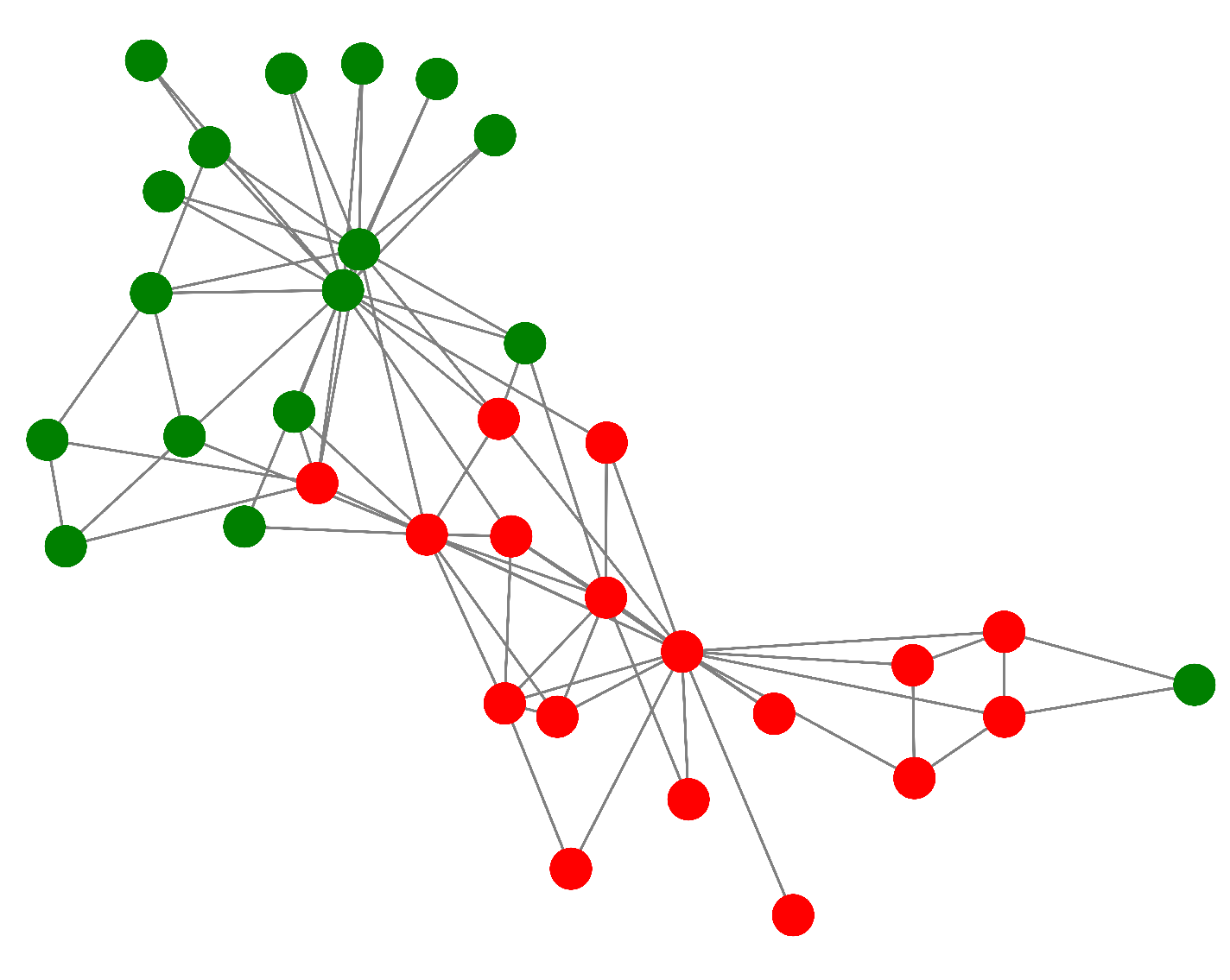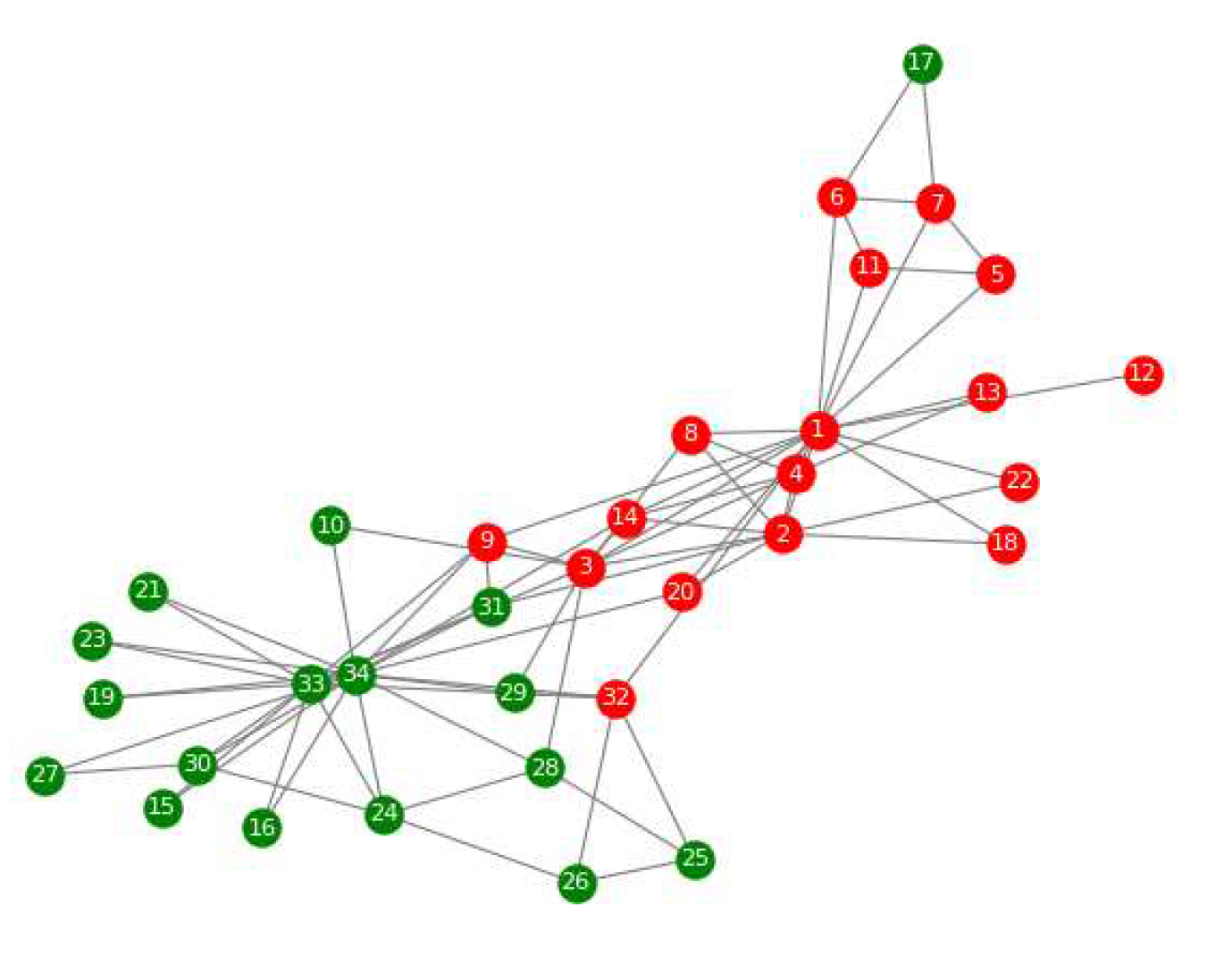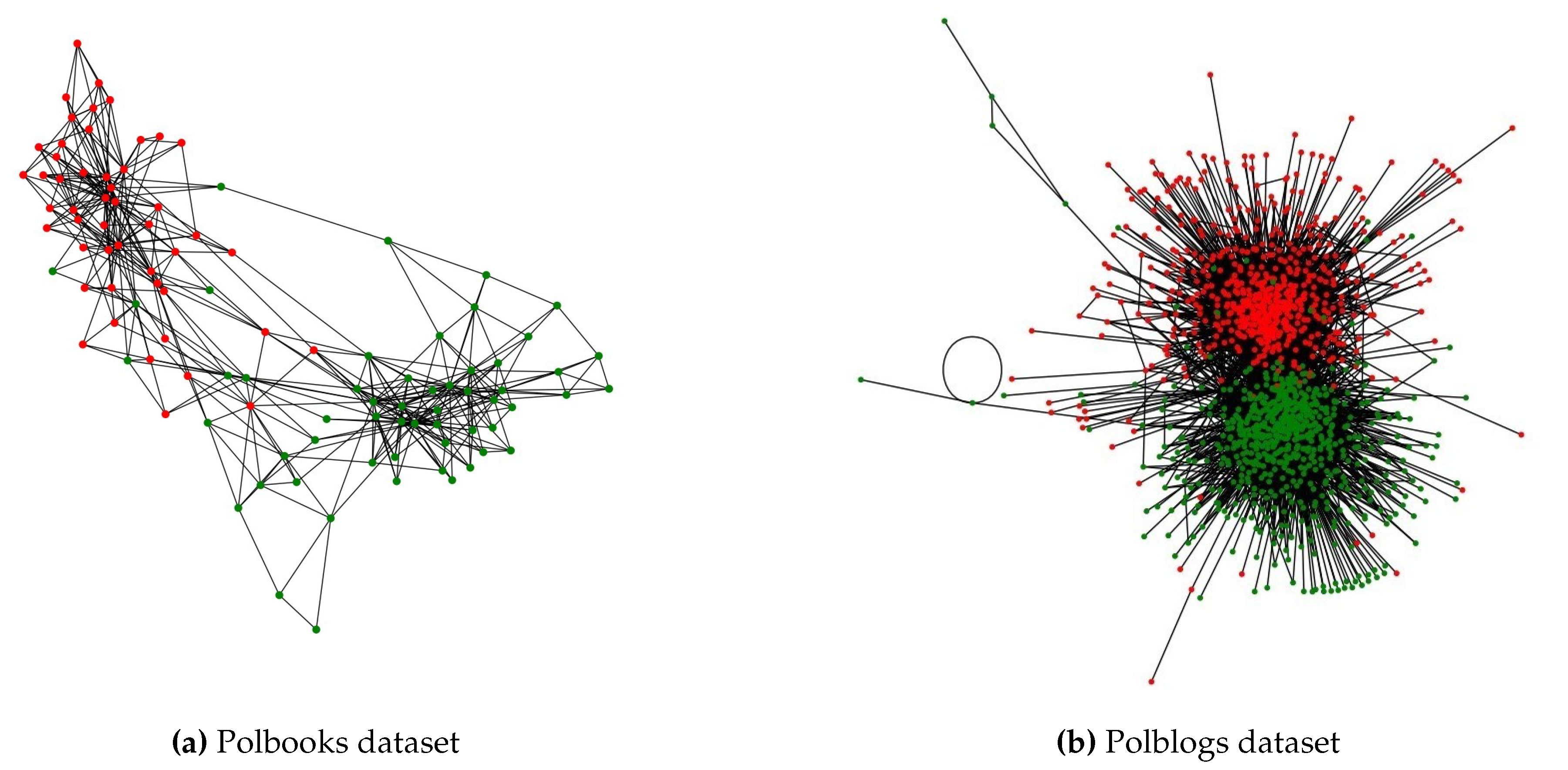Submitted:
19 September 2023
Posted:
20 September 2023
You are already at the latest version
Abstract
Keywords:
1. Introduction
1.1. Problem of Polarization
1.2. Effects of Polarization
1.3. Solution Space
1.4. Proposed Solution
1.5. How This Work is Different From Others
1.6. Datasets
2. Literature Review
2.1. Diversity Measures
2.2. Polarization Measures
- Opinion component: How the people’s ideologies diverge.
- Structural component: How the network is structured (Person X is friends with Person Y). Connections with like-minded individuals. If there is no community structure, each individual is connected to every other individual and thus exposed to multiple views. If there are clear communities, individuals will only be exposed to ideas within that community.
-
Interplay between Opinion component and Structural Component:
- a
- Depending on the system’s meso level organization, the same communities and opinions might produce varying degrees of polarization. Communities that can openly connect with one another regardless of their political views show less polarization than those that form in increasingly severe echo chambers. The polarization measure is modeled as a node vector distance problem. L = estimate of the effective “resistance” between two nodes in a system. This is done using a pseudo-inverse Laplacian to estimate the effective resistance. The result of this operation is then inverted (Moore-Penrose pseudo-inverse) to get L which gives us a good notion of the distance between two vectors say a and b. They divided the vector o into the vectors o+ and o in order to apply GE to estimate polarization. O- contains the absolute value of all negative opinions and 0 otherwise, while O+ contains all positive opinions After that, their measure of polarization becomes:
2.3. Controversy Measures
2.4. Recommendation Systems
2.5. Methods of Polarization Reduction
- Moderate Internal: Attempt to moderate the internal opinion of individuals and bring it to (through educational interventions).
- Moderate External: Attempt to moderate the external opinion of individuals and bring it to 0 (this can be done through incentives).
3. Proposed polarization metric
4. Methodology
4.1. Factor Analysis
- The distance metric: The distance metric indicates the degree of divergence or disagreement between the opinion values of nodes both within and between communities. Greater polarization and ideological division are indicated by a greater gap. Various methods have been investigated in the literature already, which measure the separation between opinion nodes. In this study, we use the "Distance Metrics" method, concentrating on the separation between the two different opinion groups’ centers of gravity, i.e.
- Intra-Community Connection Strength: The degree of cohesion and alignment among those who hold similar views is shown by the strength of connections within each group. Communities that are more cohesive tend to develop echo chambers.
- Inter-Community Connectivity: The information flow and potential exposure to other viewpoints are influenced by the existence of connections between persons from various communities. Greater polarization is correlated with decreased intercommunity connectivity.
- 4.
- Density of Boundary Edges: Boundary edges, which indicate relationships between members of various communities, are very important in determining the degree of polarization. A greater density of these edges suggests a greater mingling of viewpoints, which would lessen polarization. A precise and consistent methodology is used to calculate the social network’s density of boundary edges () properly. The ratio of the number of actual boundary edges () to the total number of potential boundary edges () in the network is the definition of this statistic. The determination of is crucial because it provides insight into the interaction of views among various communities within the network. It is possible to gather important knowledge about the degree of interaction and information flow between members of various ideological groups by assessing the density of boundary edges. A higher value denotes a better level of community connection, which may minimize polarization, whereas a lower value denotes more splintered and polarized groupings. The inverse of is utilized here, which is denoted by , called sparsity, to measure polarization. The sparsity of edges between groups is effectively captured by this transformation, allowing for a more accurate evaluation of the degree of polarization in the social network.
4.2. Formulation of polarization pointer
4.3. Proposed Opinion Evolution Model
5. Results and Discussion
Minimization Problem: Optimal Reduction of Polarization
1. Introduction
2. Variables and Definitions
3. Minimization Objective
4. Optimization Problem Formulation
5. Solving the Optimization Problem
Node Grouping and Selection:
Identifying Optimal Node Pairs:
Edge Addition Strategy:

6. Conclusions
References
- Ko, H.; Lee, S.; Park, Y.; Choi, A. A Survey of Recommendation Systems: Recommendation Models, Techniques, and Application Fields. Electronics 2022, 11, 141. [Google Scholar] [CrossRef]
- Beheshti, A.; Yakhchi, S.; Mousaeirad, S.; Ghafari, S.M.; Goluguri, S.R.; Edrisi, M.A. Towards Cognitive Recommender Systems. Algorithms 2020, 13, 176. [Google Scholar] [CrossRef]
- Abbasi-Moud, Z.; Vahdat-Nejad, H.; Sadri, J. Tourism Recommendation System Based on Semantic Clustering and Sentiment Analysis. Expert Syst. Appl. 2021. [Google Scholar] [CrossRef]
- Liu, F.; Lee, H. Use of Social Network Information to Enhance Collaborative Filtering Performance. Expert Syst. Appl. 2010. [Google Scholar] [CrossRef]
- Yang, B.; Lei, Y.; Liu, J.; Li, W. Social Collaborative Filtering by Trust. IEEE Trans. Pattern Anal. Mach. Intell. 2017, 39. [Google Scholar] [CrossRef]
- Amato, F.M.V.P.A.P.F. SOS: A Multimedia Recommender System for Online Social Networks. Future Gener. Comput. Syst. 2019, 93, 914–923. [Google Scholar] [CrossRef]
- Capdevila, J.A.M.A.A. GeoSRS: A Hybrid Social Recommender System for Geolocated Data. Inf. Syst. 2016, 57, 111–128. [Google Scholar] [CrossRef]
- Tarus, J.N.Z.Y.A. A Hybrid Knowledge-Based Recommender System for e-Learning Based on Ontology and Sequential Pattern Mining. A Hybrid Knowledge-Based Recommender System for e-Learning Based on Ontology and Sequential Pattern Mining 2017, 72, 37–48. [Google Scholar] [CrossRef]
- Choi, S.M.K.S.K.H.Y.S. A Movie Recommendation Algorithm Based on Genre Correlations. Expert Syst. Appl. 2012, 39, 8079–8085. [Google Scholar] [CrossRef]
- Walek, B.F.V. A Hybrid Recommender System for Recommending Relevant Movies Using an Expert System. Expert Syst. Appl 2020, 158. [Google Scholar] [CrossRef]
- Pan, Y.H.F.Y.H. Learning Social Representations with Deep Autoencoder for Recommender System. World Wide Web 2020, 23, 2259–2279. [Google Scholar] [CrossRef]
- Aivazoglou, M.R.A.M.D.V.C.I.S.P.J.S.D. A Fine-Grained Social Network Recommender System. Soc. Netw. Anal. Min. 2020, 10, 8. [Google Scholar] [CrossRef]
- García-Sánchez, F.C.P.R.V.G.R. A Social-Semantic Recommender System for Advertisements. Inf. Process. Manag. 2020, 57, 102153. [Google Scholar] [CrossRef]
- Kaufman, E. The social media, the mass media, violence and democracy. The arena for institutional weakening and citizens lack of confidence. Political Science 2018. [Google Scholar]
- Gillani, N.; Yuan, A.; Saveski, M.; Vosoughi, S.; Roy, D. Me, My Echo Chamber, and I: Introspection on Social Media Polarization. WWW ’18: Proceedings of the 2018 World Wide Web Conference, 2018, p. 823–831.
- Donkers, T.; Ziegler, J. The Dual Echo Chamber: Modeling Social Media Polarization for Interventional Recommending. RecSys ’21: Proceedings of the 15th ACM Conference on Recommender Systems, 2021, p. 12–22.
- Sobkowicz, P. Social Depolarization and Diversity of Opinions—Unified ABM Framework. MDPI 2023, 25, 568. [Google Scholar] [CrossRef] [PubMed]
- Akçay, N.C. A Comparison Of The Cultural Diplomacy Policies Of France And The United Kingdom Towards African Countries. Master’s thesis, Hacettepe University Graduate School of Social Sciences Turkey, 2018.
- Sun, N. Overview of definition, evaluation, and algorithms of serendipity in recommender systems. Proceedings of the 3rd International Conference on Signal Processing and Machine Learning, 2023, Vol. 6, pp. 640–646.
- Kotkov, D.; Wang, S.; Veijalainen, J. A survey of serendipity in recommender systems. Knowledge-Based Systems 2016, 111, 180–192. [Google Scholar] [CrossRef]
- Maksai, A.; Garcin, F.; Faltings, B. Predicting Online Performance of News Recommender Systems Through Richer Evaluation Metrics. RecSys ’15: Proceedings of the 9th ACM Conference on Recommender Systems, 2015, p. 179–186.
- Zhang, Y.C.; Séaghdha, D.Ó.; Quercia, D.; Jambor, T. Auralist: introducing serendipity into music recommendation. WSDM ’12: Proceedings of the fifth ACM international conference on Web search and data mining, 2012, p. 13–22.
- Kotkov, D.; Veijalainen, J.; Wang, S. Challenges of Serendipity in Recommender Systems. WEBIST 2016 : Proceedings of the 12th International conference on web information systems and technologies, 2016, Vol. 2.
- Kotkov, D.; Veijalainen, J.; Wang, S. A Serendipity-Oriented Greedy Algorithm for Recommendations. WEBIST 2017 : Proceedings of the 13rd International conference on web information systems and technologies, 2017, Vol. 1, pp. 32–40.
- W., Z. W., Z. An information flow model for conflict and fission in small groups. Journal of Anthropological Research.
- Krebs, V. Books about US politics. http://www.orgnet.com/, 2004.
- Adamic, L.A.; Glance, N. The political blogosphere and the 2004 U.S. election: divided they blog. LinkKDD ’05: Proceedings of the 3rd international workshop on Link discovery, 2005, p. 36–43.
- Matakos, A.; Gionis, A. Tell me Something My Friends do not Know: Diversity Maximization in Social Networks. IEEE International Conference on Data Mining (ICDM);, 2018; pp. 327–336.
- Vendeville, A.; Giovanidis, A.; Papanastasiou, E.; Guedj, B. Opening up Echo Chambers via Optimal Content Recommendation. International Conference on Complex Networks and Their Applications XI. COMPLEX NETWORKS 2016 2022, 2023, Vol. 1077, p. 74–85.
- Akoglu, L. Quantifying political polarity based on bipartite opinion networks. Proceedings of the 8th International Conference on Weblogs and Social Media, ICWSM 2014.
- Guerra, P.C.; Jr, W.M.; Cardie, C.; Kleinberg, R.D. A Measure of Polarization on Social Media Networks Based on Community Boundaries. Proceedings of the International AAAI Conference on Web and Social Media, 2013.
- Morales, A.J.; Borondo, J.; Losada, J.C.; Benito, R.M. Measuring political polarization: Twitter shows the two sides of Venezuela. Chaos 25 2015, 25. [Google Scholar] [CrossRef] [PubMed]
- Hohmann, M.; Devriendt, K.; Coscia, M. Quantifying ideological polarization on a network using generalized Euclidean distance. Science Advances 2023, 9. [Google Scholar] [CrossRef] [PubMed]
- Matakos, A.; Terzi, E.; Tsaparas, P. Measuring and moderating opinion polarization in social networks. Data Mining and Knowledge Discovery 31, 1480. [Google Scholar]
- Cinus, F.; Minici, M.; Monti, C.; Bonchi, F. The Effect of People Recommenders on Echo Chambers and Polarization. Proceedings of the Sixteenth International AAAI Conference on Web and Social Media, 2022, Vol. 16.
- Vicario, M.D.; Vivaldo, G.; Bessi, A.; Zollo, F.; Scala, A.; Caldarelli, G.; Quattrociocchi, W. Echo Chambers: Emotional Contagion and Group Polarization on Facebook. Scientific Reports 2016, 6. [Google Scholar] [CrossRef] [PubMed]
- Chitra, U.; Musco, C. Analyzing the Impact of Filter Bubbles on Social Network Polarization. WSDM ’20: Proceedings of the 13th International Conference on Web Search and Data Mining, 2020, p. 115–123.
- Garimella, K.; Morales, G.D.F.; Gionis, A.; Mathioudakis, M. Quantifying Controversy in Social Media. CoRR, 1507. [Google Scholar]
- Zhang, M.; Hurley, N. Avoiding monotony: improving the diversity of recommendation lists. RecSys ’08: Proceedings of the 2008 ACM conference on Recommender systems, 2008, p. 123–130.
- Gao, Z.; Shen, T.; Mai, Z.; Bouadjenek, M.R.; Waller, I.; Anderson, A.; Bodkin, R.; Sanner, S. Mitigating the Filter Bubble While Maintaining Relevance: Targeted Diversification with VAE-based Recommender Systems. SIGIR ’22: Proceedings of the 45th International ACM SIGIR Conference on Research and Development in Information Retrieval, 2022, p. 2524–2531.
- Ziegler, C.N.; McNee, S.M.; Konstan, J.A.; Lausen, G. Improving recommendation lists through topic diversification. WWW ’05: Proceedings of the 14th international conference on World Wide Web, 2005, p. 22–32.
- Castells, P.; Vargas, S.; Wang, J. Novelty and diversity metrics for recommender systems: Choice, discovery and relevance. International Workshop on Diversity in Document Retrieval, 2011.
- Murakami, T.; Mori, K.; Orihara, R. Metrics for Evaluating the Serendipity of Recommendation Lists. New Frontiers in Artificial Intelligence, 2009, Vol. 4914, p. 40–46.
- Keefer, P.; Knack, S. Polarization, Politics and Property Rights: Links Between Inequality and Growth. Public Choice volume 111.
- Garimella, K.; De Francisci Morales, G.; Gionis, A.; Mathioudakis, M. Reducing Controversy by Connecting Opposing Views. Proceedings of the Tenth ACM International Conference on Web Search and Data Mining; ACM: New York, NY, USA, 2017. [Google Scholar] [CrossRef]
- Garimella, K.; Gionis, A.; Parotsidis, N.; Tatti, N. Balancing Information Exposure in Social Networks. CoRR 2017, abs/1709.01491, [1709.01491].
- Musco, C.; Musco, C.; Tsourakakis, C.E. Minimizing Polarization and Disagreement in Social Networks. Proceedings of the 2018 World Wide Web Conference; International World Wide Web Conferences Steering Committee: Republic and Canton of Geneva, Switzerland, 2018. [Google Scholar] [CrossRef]






| Dataset Name | Number of Nodes | Number of Edges |
|---|---|---|
| Karate | 34 | 78 |
| Polbooks | 105 | 441 |
| Polblogs | 1222 | 16717 |
| Synthetic Data | 6000 | 600000 |
| G1 edges | G2 edges | B_edges | Total edges | Polarization |
|---|---|---|---|---|
| 20000 | 15000 | 20000 | 55000 | 0.5567 |
| 50000 | 35000 | 20000 | 105000 | 0.7036 |
| 120000 | 115000 | 20000 | 255000 | 0.7947 |
| 130000 | 165000 | 20000 | 315000 | 0.8139 |
| G1 edges | G2 edges | B_edges | Total edges | Polarization |
|---|---|---|---|---|
| 130000 | 165000 | 50000 | 345000 | 0.7452 |
| 130000 | 165000 | 80000 | 375000 | 0.6906 |
| 130000 | 165000 | 110000 | 405000 | 0.6415 |
| 130000 | 165000 | 150000 | 445000 | 0.5908 |
Disclaimer/Publisher’s Note: The statements, opinions and data contained in all publications are solely those of the individual author(s) and contributor(s) and not of MDPI and/or the editor(s). MDPI and/or the editor(s) disclaim responsibility for any injury to people or property resulting from any ideas, methods, instructions or products referred to in the content. |
© 2023 by the authors. Licensee MDPI, Basel, Switzerland. This article is an open access article distributed under the terms and conditions of the Creative Commons Attribution (CC BY) license (http://creativecommons.org/licenses/by/4.0/).




